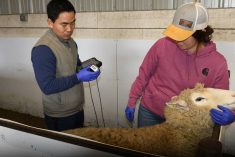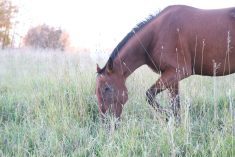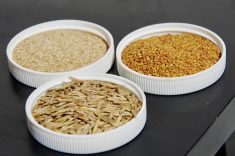Sheep producers need to watch for abortions, stillbirths and weak lambs during the upcoming lambing season, according to North Dakota State University Extension Service sheep specialist Reid Redden.
“Numerous infectious agents are commonly found in U.S. sheep flocks, and they can cause diseases such as chlamydia, vibriosis and toxoplasmosis,” he says.
Chlamydia is caused by a pathogen that is transmitted through the placenta and birthing fluids. Unexposed ewes, including ewe lambs, have a high rate of abortion (20 to 30 per cent), whereas previously exposed ewes have a much lower rate of abortion (zero to five per cent).
Read Also

Pig transport stress costs pork sector
Popular livestock trailer designs also increase pig stress during transportation, hitting at meat quality, animal welfare and farm profit, Agriculture and Agri-Food Canada researcher says
A high rate of weak and unhealthy lambs can be a sign of chlamydia in a sheep flock, Redden says. He suggests adding feed-grade antibiotics to late-gestation diets to treat ewe flocks diagnosed with chlamydia.
Vaccines can improve resistance to the disease, he adds. However, they are not 100 per cent effective and do not provide lasting immunity.
“Chlamydia also has the potential to cause human disease, especially in pregnant women,” NDSU Extension veterinarian Charlie Stoltenow says. “Women who are pregnant or planning to become pregnant should limit their exposure to pregnant ewes.”
Vibriosis, also known as campylobacteriosis, is caused by bacteria that are transmittable through birthing fluid.
Previously exposed ewes appear to develop protective immunity. Feed-grade and injectable antibiotics can be used to treat the disease during an outbreak. Vaccines are available; however, they must be given every year prior to breeding and during mid-gestation.
Toxoplasmosis is a disease that almost always results
from feed contamination by cat feces and/or birthing fluids. Unless ewes previously were exposed to the toxoplasmosis, the infectious agent will invade the placenta and cause placentitis, an inflammation of the placenta.
Exposure during early gestation may lead to fetal reabsorption or expulsion, and late-gestation exposure may lead to stillbirths or weak lambs. No effective treatment is available.
“Prevention is the key to protecting ewes from these disease-causing agents,” Redden says. “Most all ewe abortions result from ingestion of either contaminated feed or birthing fluids of infected ewes, so access to clean, high-quality feed and water during gestation and proper disposal of placentas are crucial to reducing the likelihood of ewe diseases.”
Here is what producers should do if a ewe aborts a pregnancy:
Separate the ewe from the flock.
Properly dispose of the placenta, fetus and contaminated bedding to reduce any further flock exposure. Handling these items is a human health risk, so wear gloves.
Contact your veterinarian to properly diagnose the infectious agent that caused the abortion.
Maintain current vaccination programs if positive diagnoses have been made on your flock.
Consider whether using feed-grade antibiotics during late gestation is appropriate for your flock health.
———
“Womenwhoarepregnantorplanning tobecomepregnantshouldlimittheir exposuretopregnantewes.”


















